Where to Purchase Citrine: A Complete Guide


Intro
Citrine is a jewel that captivates many, shimmering with shades of yellow and golden hues. Its allure is not just surface deep; it holds a rich history intertwined with various cultures, showcasing its value far beyond the mere aesthetics. For collectors, understanding where to obtain this gemstone is crucial. Whether you are an avid enthusiast or just starting your journey, this guide seeks to illuminate the pathways to acquiring citrine.
History and Origins
Overview of Collectibles, Rocks, and Fossils
In the sphere of geology and mineralogy, citrine finds its position among collectibles, rocks, and fossils. Noted for its vibrant colors and the warmth it exudes, citrine is a variety of quartz rich in iron, which gives it a unique color palette ranging from pale yellow to deep amber. It has become a favorite among collectors who admire its beauty and metaphysical properties.
Citrine forms under conditions that can be found mostly in Brazil, Spain, and Madagascar. Each region offers subtle variations in hue and clarity, adding layers of complexity to its classification. Collectors often seek out these regional traits, understanding that the origin can sometimes affect both the value and desirability of the stone.
Historical Significance and Cultural Impact
Historically, citrine has been used as a talisman or amulet across various cultures. Ancient Greeks believed it held immense powers, using it as a protective stone against evil. In many parts of the world, citrine's vibrant color symbolized the sun and prosperity, often being referred to as the "Merchant's Stone" because of its association with wealth and success in trade.
In the 18th century, the gemstone made a mark in European jewelry, becoming fashionable among the aristocracy. The emotional connection people have with citrine persists even today, manifesting in its ongoing popularity.
"Citrine is not merely a stone; it gives life a sparkle, igniting the imagination and inspiring creativity."
Key Considerations When Purchasing Citrine
Before diving into where to buy citrine, having a grasp of its historical significance can greatly enhance your appreciation of the stone. Factors like authenticity, ethical sourcing, and regional significance should not be overlooked.
- Authenticity: Always ensure that you are purchasing genuine citrine, as the market is flooded with heat-treated amethyst being sold as citrine. Look for reputable dealers who provide verification of authenticity, certificates, or guarantees to safeguard your investment.
- Ethical Sourcing: In today's age, being conscious about where and how gemstones are sourced has become increasingly vital. Seek sellers who are transparent about their sourcing practices to support sustainability.
- Pricing: The price of citrine can fluctuate based on its quality, size, and origin. On average, it can range broadly, reflecting its availability. Comparing prices across various vendors can help you find the best deal without compromising on quality.
Understanding these considerations will not only guide your shopping experience but also enhance your overall knowledge about citrine.
Identification and Classification
Guide to Identifying Citrine
Identifying citrine from other gemstones can sometimes be tricky, especially when they share similar visual attributes. Here, we break down key features to look for:
- Color: Natural citrine typically displays a uniform vivid yellow or golden hue. Inspect for any zoning or color banding which can indicate it’s a different type of stone.
- Transparency: Quality citrine is often transparent to translucent. Inclusions may occur, but they should not detract from the overall appearance of the stone.
- Hardness: Citrine ranks 7 on the Mohs scale. Scratches on a less hard material may suggest that the stone is not genuine citrine.
Common Types and Variations
Citrine can vary slightly by origin and treatment methods. Here’s a brief overview:
- Natural Citrine: Formed by natural geological processes, this is the most prized type due to its authenticity.
- Heat-treated Amethyst: Often misrepresented as citrine, these stones are transformed through heat treatment but don’t hold the same value.
- Smoky Citrine: This variation contains brown hues, further broadening the spectrum for collectors.
Each type of citrine has its charm and allure, appealing to different preferences and styles among collectors.
Prolusion to Citrine
Citrine has carved out a unique niche in the realm of gemstones, celebrated not just for its warm, golden hues but also for its myriad of purported benefits. As we delve into the importance of this alluring stone, it’s crucial to comprehend its value, not merely as an ornament, but as a collector's gem with rich historical connotations and modern significance. The rising trend among enthusiasts underscores a burgeoning interest in citrine which extends beyond aesthetics, prompting the need for a comprehensive guide on where to acquire it.
The charm of citrine lies in its versatility. From cocktail rings to statement necklaces, this gemstone suits various styles, appealing to a broad audience. For amateur and seasoned collectors alike, understanding how to seek out quality citrine can make a world of difference. With several options in today’s marketplace—both physical and online options—informing oneself about where to purchase citrine not only safeguards against potential pitfalls, but it also enhances the collecting experience.
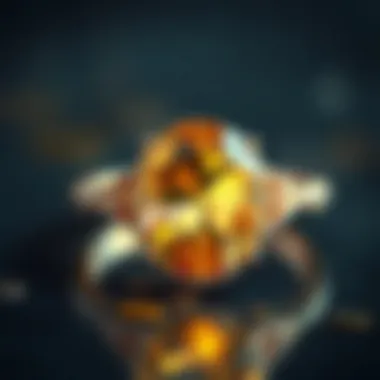

In this article, we will chart the many pathways leading to the acquisition of citrine, aimed at empowering buyers with knowledge. We'll touch on the historical significance this stone holds, revealing the layers of intrigue beneath its surface. When armed with insight about its authentic variations, collectors will find themselves far better positioned to make sound investments.
What is Citrine?
Citrine is a gemstone that belongs to the quartz family, characterized by its striking yellow to brownish-orange color. This vibrant hue arises from trace amounts of iron present in the crystal structure. Unlike synthetic alternatives, genuine citrine is a product of natural geological processes and is often found in locations like Brazil, Madagascar, and Spain. The demand for this stone, both for ornamental use and believed metaphysical properties, has grown substantially over the years.
When referring to citrine, it’s essential to distinguish between natural citrine, which is formed in the earth, and heat-treated amethyst or smoky quartz that has been transformed to appear like citrine. Collectors place high value on natural citrine due to its authenticity and rarity. This preference inherently influences the market dynamics surrounding citrine's supply and pricing.
Historical Significance of Citrine
The story of citrine is etched in the annals of ancient civilizations. In fact, its name is derived from the French word "citron," meaning lemon, a nod to its vibrant coloration. This stone was treasured by Greeks and Romans alike, who believed it held protective qualities against negative energy and served as a source of wealth. Throughout history, citrine has been associated with prosperity and success, particularly among the affluent.
In the 18th century, citrine found its way into the jewelry of nobility, enhancing its reputation as a luxury gemstone. It was during this period that the stone began to be cut into various shapes and styles, making it a staple for bespoke jewelry pieces. In various cultures, citrine was revered for its supposed ability to promote mental clarity and attract abundance, solidifying its reputation through positive lore. This historical context not only adds depth to the gem but offers insight into why modern collectors should explore each piece’s background before acquisition.
Analyzing both the scientific validity and historical narratives attached to citrine enriches the purchasing experience, enriching an individual’s collection with not just a stone, but a story. Given its multi-dimensionality, citrine continues to captivate, making it an outstanding choice for those looking to find both beauty and substance in their gemstone pursuits.
Primary Marketplaces for Citrine
When it comes to acquiring citrine, understanding the primary marketplaces is pivotal for collectors and enthusiasts alike. Citrine, known for its vibrant hues of yellow to brownish orange, is commonly available through various channels. Knowing where to search will not only broaden your options but also enhance your chances of scoring the best pieces. Moreover, the marketplace's distinct characteristics often dictate pricing, authenticity levels, and customer experience.
Local Gem Shows and Trade Fairs
Local gem shows and trade fairs are often treasure troves for mineral collectors, providing unique opportunities to purchase citrine directly from vendors. These events typically feature a wide variety of gemstones, including self-displays from local artisans to established dealers. The vibrant atmosphere of a gem show allows enthusiasts to engage personally with sellers, often leading to better deals and invaluable knowledge about the stones they’re interested in.
Visiting these fairs can be advantageous due to the hands-on experience it offers. You can physically inspect the citrine pieces, evaluating their color, clarity, and cut in person. It’s also possible to negotiate prices, especially when purchasing multiple items. Most importantly, you can ask questions about the stones' origins, unearthing information that can aid in discerning quality and authenticity. Keep an eye out for dates and locations of gem shows on platforms like GemShow.com or community bulletin sites.
Jewelry Stores and Retail Outlets
Jewelry stores and retail outlets remain a reliable source for purchasing citrine. These establishments usually offer a curated selection of gemstones, with trained staff available to provide guidance. One significant advantage of buying from a reputable jeweler is the level of assurance they typically provide regarding the authenticity and quality of their products.
While larger chains may have standardized inventory, smaller local jewelers often showcase unique, handcrafted pieces that embody the artistry of gem crafting. It’s advisable to check for certifications or lab reports, especially for higher-value citrine pieces, as this greatly enhances trust in the purchase.
Some stores also offer customization services, allowing you to design a unique piece that fits your personal taste, thereby adding sentimental value to your citrine acquisition. If you're uncertain about where to begin your search, local business directories or jewelry associations like the Jewelers of America can provide valuable leads.
Online Marketplaces
In today’s digital age, online marketplaces have transformed the way we acquire citrine. Entering a virtual marketplace allows access to a broader range of options from the comfort of your home. Major platforms like eBay, Etsy, and Amazon feature numerous listings, catering to different budgets and aesthetic preferences. However, while online purchases offer convenience, they come with their own set of considerations.
When shopping online, be vigilant about seller reviews and ratings. Always glance through customer feedback and request detailed photographs of the citrine to ensure clarity and hue integrity. Some websites may even provide return policies, adding an extra layer of security to your transaction.
Also, specialized sites like GemRockAuctions.com can connect you with trusted dealers who focus solely on gemstones, thus reducing the risk of potential scams. As you navigate the online landscape, keep in mind that while the selection is vast, the key lies in verifying the seller's credibility and the authenticity of the gemstone being offered.
Specialty Sources for Citrine
When hunting for citrine, specialty sources can be a treasure trove. These avenues often house unique pieces and seldom-seen varieties that larger retailers may overlook. Whether you're an avid collector or a casual buyer, these sources provide an opportunity not just to purchase but to engage with the gem community.
Mineral and Gem Shops
Mineral and gem shops present a vibrant atmosphere filled with knowledge and enthusiasm about rocks and stones. These shops often stock local finds as well as stones sourced globally. The advantage here is direct access to shop owners or enthusiasts who can share stories about the origins of their stones. A little face-to-face interaction can enlighten you about how citrine was formed and the conditions surrounding its creation. When visiting, pay attention to the display cases and inquire about less common types of citrine.
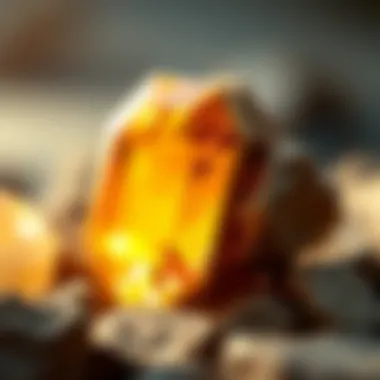
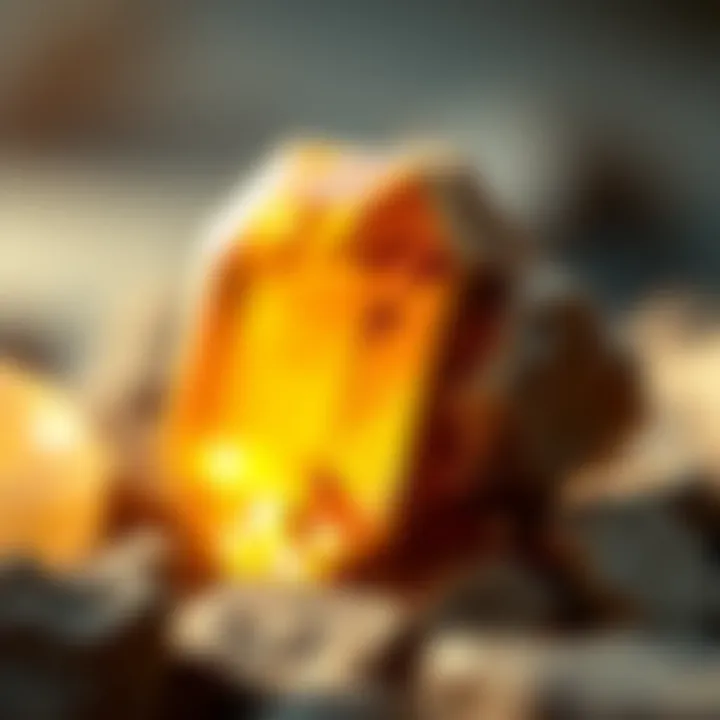
- Personal Interaction: You can discuss details about the gems, such as their history and treatment. This often leads to a deeper appreciation for each piece.
- Variety: Smaller shops may offer unique cuts and colors of citrine that you wouldn't find at large retail outlets.
- Local Stories: Supporting small businesses often means buying stones sourced from local miners and artisans.
Auction Houses and Collectible Brokers
Auction houses can be an exciting option for finding high-quality citrine pieces. These establishments typically cater to serious collectors looking for rare, one-of-a-kind gems. The bidding process might seem intimidating at first, but it opens doors to rare finds. Collectible brokers often curate items of significant value and history, making them ideal for someone looking to make a strong investment.
- Access to Rarity: Auctions might feature high-end stones that are not readily available
- Expert Appraisals: Auctions frequently come with certifications, ensuring you're making a well-informed choice.
- Competitive Pricing: Sometimes, you might snag a gem at a favorable price due to the nature of auctioning.
"Buying at auction is like going on a treasure hunt - you never know what you might uncover!"
Ethical Gem Suppliers
The rise in demand for ethically sourced stones has changed the market landscape. Ethical gem suppliers focus on sourcing from miners and operations that prioritize fair labor practices and sustainability. For the environmentally conscious collector, these suppliers provide a sense of assurance regarding the origins of the citrine.
- Transparency: Most ethical suppliers are proud to share their sourcing stories, which often include certifications about sustainable practices.
- Community Support: By choosing ethical suppliers, you support local communities that might rely on gem mining as a source of income.
- Quality Assurance: Stones sourced ethically often adhere to stricter quality standards, ensuring you receive a high-quality gem without moral compromise.
In summary, exploring these specialty sources can significantly enrich your citrine acquisition experience. From the tactile interaction in local shops to the excitement of auctions and the peace of mind provided by ethical suppliers, these avenues offer more than just transactions—they provide connections to the broader world of gemstones.
Assessing Quality When Buying Citrine
When it comes to purchasing citrine, one cannot simply load up on any piece that catches the eye. Assessing the quality of citrine is paramount for collectors and casual buyers alike, as it directly impacts both the stone's beauty and its market value. The gemstone's reputation for glowing hues of yellow and orange makes it appealing, but not all citrine is created equal. This section delves deep into what makes a quality citrine, ensuring buyers know exactly what they’re getting into.
Understanding Citrine Grades
Citrine grades are essential for distinguishing between top-notch specimens and those that may leave you disappointed. Gemologists grade citrine based largely on clarity, color, cut, and carat weight. The grading scale often starts with 'A' for very high-quality stones, down to others which are less desirable. Familiarize yourself with these grades so that you can make an informed choice.
Among the nuances, consider that the finest specimens often showcase a rich, vibrant golden-yellow color that some like to call "Imperial citrine." This is the crème de la crème, often fetching a higher price. Less desirable stones may be lighter or have a washed-out appearance.
Color and Clarity Considerations
Color is the heartbeat of citrine's allure. A high-grade citrine typically boasts a saturated, warm color that almost glows. As a buyer, don’t just rely on artificial lighting—examine the stone under natural light to get a true sense of its hue. Clarity is equally important; inclusions and blemishes can detract from the stone's overall appeal.
A key aspect of clarity is whether the stone has visible flaws. A well-crafted citrine should appear eye-clean, meaning that no blemishes or inclusions can be seen without magnification. In fact, many high-quality citrines are less likely to have any inclusions at all, which contributes to their desirability.
Consider the following aspects about color and clarity:
- Saturation: The intensity of the color, with darker being better.
- Uniformity: Stones with consistent color throughout are considered more valuable.
Cut and Carat Weight
The cut of a citrine plays a crucial role in determining its final aesthetic appeal. A well-cut stone allows light to pass through beautifully, enhancing the clarity and color. Common cuts for citrine include the round, oval, and emerald cuts. Each cut reflects light in unique ways, so choosing the right one can alter perceptions of the stone’s quality dramatically.
Carat weight, although it matters, should not overshadow other quality factors. A larger citrine may seem like a great deal, but if it’s poorly cut or has a washed-out color, it might be less desirable than a smaller, well-cut stone that flaunts vibrant color.
Consider these points when examining cut and carat:
- Angle and Symmetry: A well-proportioned citrine will exhibit dazzling brilliance and fire.
- Weight: Evaluate how the weight correlates with size; a lighter stone can sometimes surprise you with its look compared to a bulkier competitor.
In summary: The quality of citrine can make or break your buying experience. Understanding grades, color, clarity, cut, and carat weight ensures that you invest in what truly brightens your collection. Take your time, examine each piece closely, and you’ll surely find a gem that meets your expectations.
Verifying Authenticity of Citrine
When it comes to purchasing citrine, a fundamental aspect that can’t be overlooked is the verification of authenticity. In the world of gemstones, not all that glitters is genuine. Citrine, while beautiful and often sought after, can be misrepresented. This makes understanding how to differentiate between authentic and synthetic stones essential for both novice buyers and seasoned collectors.
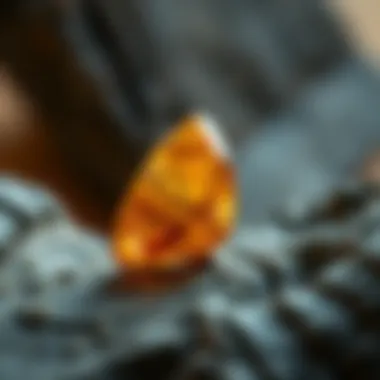
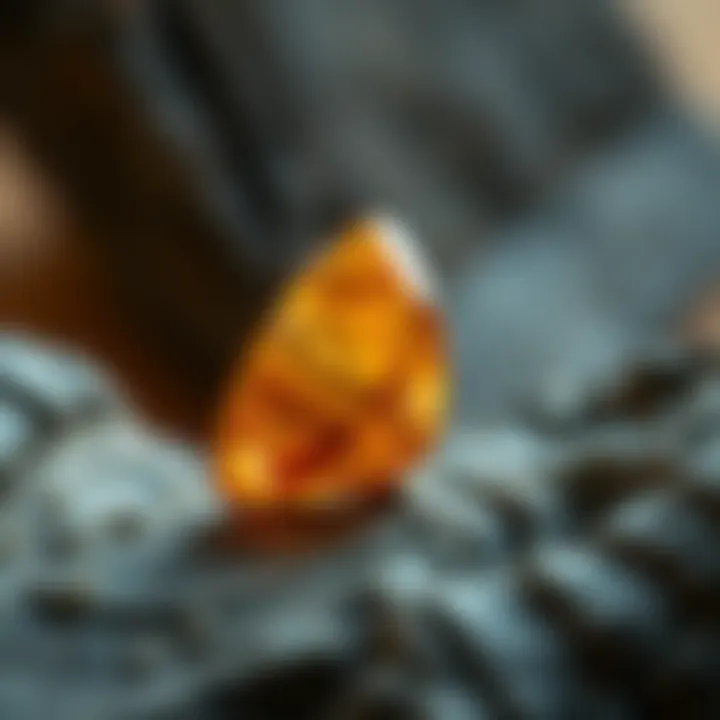
Verifying authenticity can save buyers from falling prey to scams and ensure that they acquire real citrine that holds its value. Moreover, genuine citrine carries a unique energy and beauty that synthetic counterparts simply cannot replicate. So, how do you spot the real deal?
Identifying Natural vs. Synthetic Citrine
The distinction between natural and synthetic citrine is critical. Natural citrine is formed through geological processes over millions of years, whereas synthetic citrine is man-made, often produced in laboratories. While both may appear similar to the naked eye, there are several methods to tell them apart.
- Visual Inspection: Natural citrine often contains unique inclusions or slight imperfections that indicate its origin. Synthetic citrine, on the other hand, might display a flawless appearance, which can be a red flag.
- Color Depth: Natural citrine typically has a color that runs from pale yellow to rich golden brown. If the color seems too uniform or vibrant, especially bright neon hues, it may be synthetic.
- Refractive Index: A more technical approach involves examining the refractive index using a gem refractometer. Natural citrine has a different refractive index than its synthetic counterparts.
Engaging a professional gemologist is often the best route for a precise analysis if you’re unsure.
Certification and Appraisal Services
Another layer to consider in authenticity verification is seeking the help of certification and appraisal services. Reliable certifications can provide peace of mind that your citrine is genuine. These services assess stones based on various factors, including cut quality, clarity, and of course, authenticity.
- Reputable Organizations: Look for certificates from established gemological labs such as the Gemological Institute of America (GIA) or the International Gemological Institute (IGI). These institutions have rigorous standards and their reports hold weight in the market.
- Appraisals: An appraisal from a certified gemologist can serve as a valuable document, providing details about the stone’s characteristics and verifying its genuineness. This is particularly important for insurance purposes as well.
- Research and Networking: Engaging with collectors’ communities on platforms such as reddit.com can offer insights into trustworthy appraisers and certification entities.
"A rock is just a rock until it’s measured and certified. Then it becomes a treasure."
Potential Risks and Considerations
Buying citrine—or any gemstone, for that matter—comes with its share of potential pitfalls that can leave a buyer feeling like they’ve bitten off more than they can chew. Understanding these risks and considerations is essential, particularly for those who are new to the world of gemstones.
One key aspect to keep in mind is the prevalence of scams and misrepresentation in the market. Not everyone who sells citrine has the best intentions at heart. Sellers may pass off low-quality stones as high-grade ones. Additionally, some might attempt to sell synthetic gemstones as natural ones, leading to disappointment. It is crucial to have your wits about you and engage with reputable sellers.
Another important consideration is the return policies and guarantees available from dealers. Sometimes, a buyer might get something they believe to be citrine but upon closer inspection, it may not meet their expectations or quality standards. If the seller lacks a clear and customer-friendly return policy, you could find yourself stuck with a stone you didn’t want or that doesn’t meet your standards.
When embarking on your purchase journey, knowledge is power. Navigating the complexities of the gemstone marketplace requires a discerning eye and an understanding of consumer rights when it comes to returns and exchanges.
"A wise person once said, ‘If it seems too good to be true, it probably is.’ This adage holds especially true in the world of gemstones."
Scams and Misrepresentation
When looking to buy citrine, it's beneficial to be aware of the different types of misrepresentation that one might encounter. Some sellers might advertise citrine when they're actually selling a different gemstone or a treated variant that lacks the natural beauty of authentic stones. There are several tactics to safeguard yourself from falling into this trap:
- Research the seller: Check reviews from previous customers to gauge their reputation. Forums and social media platforms can be excellent resources for finding real-life accounts.
- Request certifications: Authentic gemstones often come with certificates verifying their quality and origin. A reputable seller will not hesitate to provide these documents.
- Learn the characteristics of citrine: Familiarize yourself with the stone’s color, clarity, and typical pricing so you are better equipped to spot a fake or overpriced stone.
By being proactive, you can significantly reduce the chances of being misled in your citrine endeavors.
Return Policies and Guarantees
The return policy of a seller plays a crucial role in the purchasing experience. You need to feel secure about your investment. Imagine receiving a stunning citrine pendant, only to realize that it doesn't match your expectations or has a blemish. Without a solid return policy in place, you might find yourself out of luck.
Here are a few tips to consider regarding return policies:
- Inspect the terms diligently: Make sure you fully understand the return policy before purchasing. Look for conditions, such as time limits or restocking fees.
- Give it a test drive: If possible, try to view the citrine in person before purchasing. Examine it under different lighting to truly appreciate its qualities.
- Inquire about guarantees: Some dealers offer limited warranties on products, covering repairs or replacements for a specific period. This can provide additional peace of mind.
Epilogue
Acquiring citrine, whether for its aesthetic appeal or metaphysical properties, carries significant weight for collectors and enthusiasts alike. Understanding the pathways to purchase this gemstone is not merely about acquiring a shiny rock; it encapsulates a broader journey of informed decisions and personal values.
Final Thoughts on Buying Citrine
When considering where to buy citrine, it’s vital to reflect on several elements:
- Knowledge is Power: Equip yourself with information about citrine grades, colors, and genuine sourcing. The more you know, the less likely you are to fall prey to unscrupulous sellers.
- Varied Avenues: From local gem shows, which foster a sense of community and allow for in-person assessment, to the convenience of online marketplaces that might present a wider selection, the decision should align with your buying preferences and needs.
- Authenticity Matters: Always prioritize verification of authenticity. Taking the extra step to secure a certification can save future heartaches and regrets.
- Ethical Considerations: The mindset of responsible purchasing is commendable. It’s important to seek ethically sourced citrine, keeping in mind the environmental and social impacts of extraction.
- Returns and Guarantees: Getting acquainted with merchants' return policies can act as a safety net, ensuring you are not stuck with a piece that doesn’t meet your expectations.
Ultimately, the way you engage with the buying process can reflect personal taste and ethical values, marking a statement in your collection. By contemplating these aspects diligently, collectors can make purchases that resonate not only with their tastes but with their principles. Remember, buying citrine is not only about acquiring a gemstone, but creating a lasting connection with its beauty and significance in your life.



